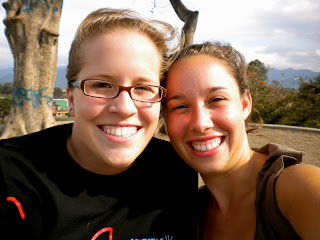My last week in Costa Rica was rather bittersweet. My trip to Panama had been exciting, and all of my classes were completed. So, I decided to spend my last week with my two best friends in Costa Rica, Emily and Melissa as well as spending as much time as possible with my host family. Melissa and I created several videos on my camera to document the culture of our neighborhood. We recorded on complete walk to school as well as a tour of our houses. I finished up my souvenir shopping in the city with two final trips to the Artisan Market downtown as well as the famous souvenir street in San Pedro. I finally bought my hammock which I had been working to bring down the price since February. It is gorgeous by the way!
One day, Melissa and I decided to take one final look at the area surrounding our neighborhood, Barrio Cordoba. There is a park that is about a ten minute walk from my house known as Parque de la Paz which means the Park of Peace. I often walked there because the park offers quiet and tranquility in a noisy city as well as entertainment on Fridays and the weekend. On the weekends, I have gone to the park to go "sledding" and to buy churros. Of course, it never snows in Costa Rica, so sledding consisted of sledding down the dirt and grass of the park's biggest hill on large pieces of cardboard. Let me tell you, sledding in snow is a lot more fun and a lot safer. The churros are good at the park too. They are not as fancy as the ones that can be found downtown...but they somehow seem more authentic when you buy them from an old man who does not speak any English at a stand at the park.
We took one final walk up this hill that has a sidewalk that winds the whole way to the top. At the top of the hill, there is one tree that is littered with the graffiti of all of the young kids who had made this place their hangout in the past. This is one of my favorite places in San José. From the tree, you have the best view of the city without having to climb one of the cloud covered mountains that surround the city. Below are some of the pictures I took from the top of the hill. If you look close enough, you can see the mountains covered by clouds in the background. Most of the mountains surrounding San José are actual mountains in a chain that stretches from Argentina to the Canadian Rocky Mountains. There are a few dormant volcanos near San José. From certain places within the city, you can see Volcan Irazú. This is the volcano that has in the past covered the cities of San José and Cartago in ash. It is said to be dormant, but no one really knows. In the second picture, you can see the downtown area which has a few high-rise buildings, most of which are relatively new. The technology used to build these high-rise buildings allows them to sway in case of an earthquake. This technology came from Japan.
 |
| In the background you can see some of the newer high-rise buildings in San José. The technology that allows the buildings to sway in the event of an earthquake came from Japan. |
 |
| Melissa and I hanging out at Parque de la Paz |
 |
| Only in Jesus is my soul at rest. |
 |
| The best view of the city! |
 |
| One of many scary Central American highways I had to cross. |
Below is a picture of the back of the laying down of arms monument in Parque de la Paz. This is how the park got its Peace name. In the museums I had visited in San José, I had learned that on December 1, 1948, Former President José Figurers Ferrer abolished the military of Costa Rica after a victory in the civil war that year. Of course, we learned in our classes that this was a very political thing as some of the presidents before Ferrer had been overthrown. He wanted to make sure that he was not overthrown. However, the Costa Rican people embraced the idea, and there has not been a need for a military ever since. In fact, one of the reasons why Costa Rica is peaceful and relatively economically stable is because the budget previously dedicated to the military now is dedicated to security, education, and culture. In 1986, President Oscar Arias Sánchez declared December 1 as the Military abolition day or Día de la Abolición del Ejército. The monumento or monument is entitled "La Destruccion de las Armas" or "The Destruction of Weapons." It is surrounded by broken weapons cemented right into the monument. I am very thankful for this monument, because Costa Rica's peacefulness is one of the reasons why it is able to focus a lot of its energy on preserving its unique environment. It also made my parents a lot more relaxed about sending me to Latin America knowing that I was traveling to one of the most peaceful countries in the world.




No comments:
Post a Comment